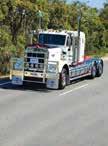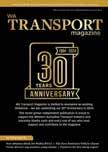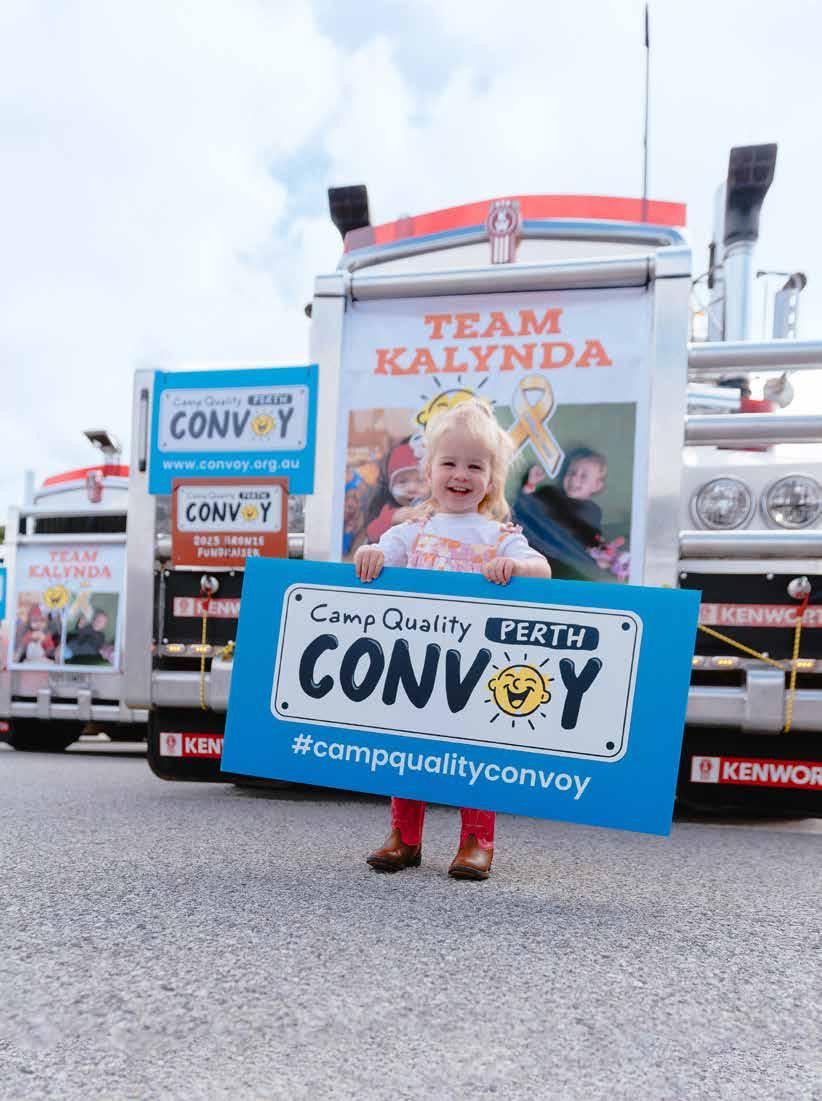

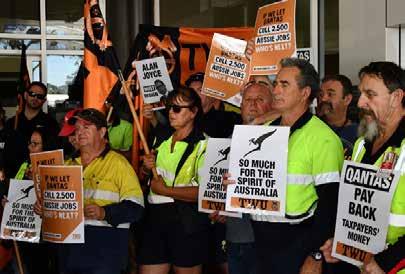
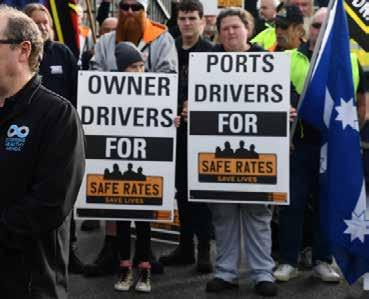
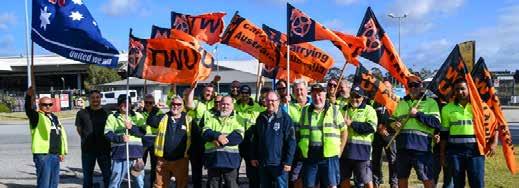










At the TWU, we are relentless in the pursuit of building and exercising worker power, guided by clear, strong principles. We are committed to earning and keeping our members’ trust and bargaining collectively. We aim to hold corporations to account, empowering the workforce with a strong and powerful voice.
The TWU has a number of Enterprise Agreements in a myriad of transport companies. If you work for a company that has an EA with the TWU, you, along with all transport workers benefit from the years of struggle and collective action of union members before you.

And set the standard for transport workers into the future.
TWU Members also benefit from a range of services available only to members
Legal Services
Wage increases and improved conditions through collective bargaining
Enforcement of your agreement and workplace rights
Representation for incidents or disciplinaries
Job Security and protection
$5,000 Funeral benefits
Free Wills
Extraordinary Driver’s License
Income Protection and Group Accident and Sickness cover
Collective purchasing power of UnionShopper to provide members with discounts on a range of restaurants, gift cards, white goods and more
You should be a member of your union, the TWU if you enjoy these benefits like:
Annual Leave
Maternity Leave
Long Service Leave
Sick days
Leave loading
Penalty rates
Superannuation
Health and safety and workers’ compensation
Allowances (meal allowances, shift allowances)
Rest breaks
Unfair dismissal protection
Becoming a member of the TWU ensures you can maintain these rights into the future.
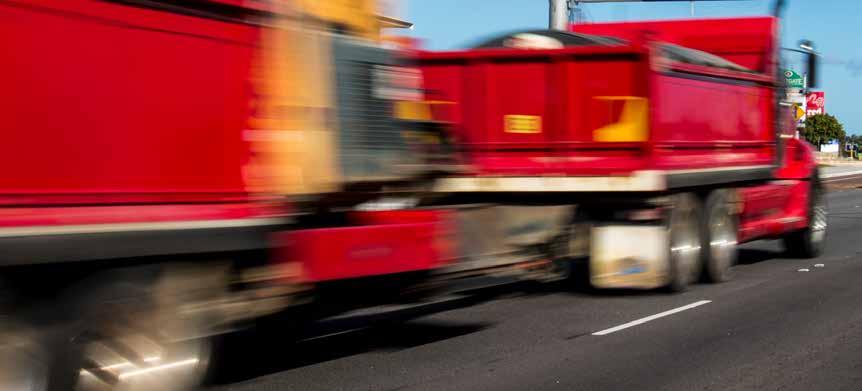
The Heavy Vehicle Helpdesk is open from: 7am to 6pm Monday to Friday, and WA Public Holidays.
On weekends the Main Roads Customer Information Centre will receive telephone calls on behalf of the Heavy Vehicle Helpdesk on 138 HVO (138 486) and email enquiries can be sent to hvs@mainroads.wa.gov.au
Tel: 138 486 Fax: 9475 8455
Email: hvs@mainroads.wa.gov.au www.mainroads.wa.gov.au
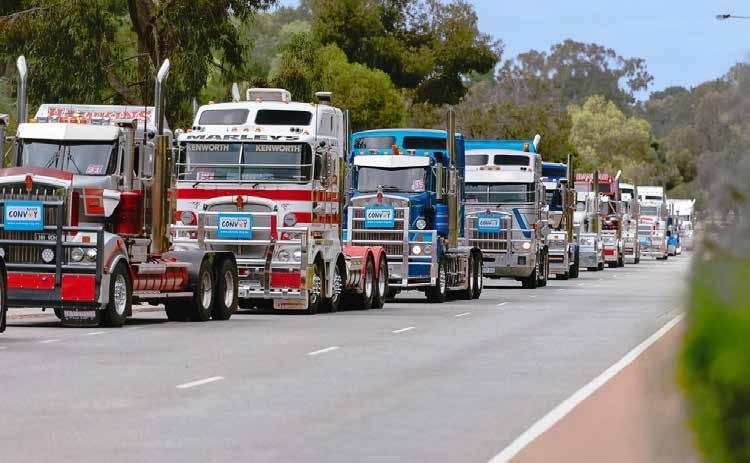
CJump in your truck and help bring fun back into the lives of
amp Quality’s Convoy Perth 2025 will bring truck drivers together to show support for kids and families experiencing the challenging realities of a cancer diagnosis.
Picture this, You’re behind the wheel of your gleaming prime mover, leading 180-plus trucks on a 40km procession around Perth.
You’re honking your horn at families waving as you roll by. You’re being celebrated for keeping the country moving. You’re raising money for kids facing cancer. You’re doing something great –something that really matters.
Sign up for Camp Quality Convoy Perth 2025, taking place on Sunday, 12 October and that could be you.
Following a record-breaking event in 2024, which raised over $400,000, Camp Quality is once again inviting the Western Australian trucking community to join the Convoy, show off their trucks and raise vital funds for kids facing cancer in one of Perth’s most fun trucking events.
Camp Quality is an Australian children’s cancer charity that has been bringing positivity, fun and laughter to kids facing cancer for more than 40 years. They help kids and families at every stage of the cancer journey, from the heartbreaking news of a cancer diagnosis, during treatment, through to remission and also in
the tragic case of bereavement.
Camp Quality Convoy Perth 2025 will start and finish at the Perth Hockey Stadium, proceeding along major roads through Bentley, Welshpool, Morley, Osborne Park and Perth City.
Back at the Perth Hockey Stadium, the Convoy Family Festival kicks off, an actionpacked celebration where the local families can cheer on the trucks as they arrive back and get up close at the crowd favourite ‘Show and Shine’.
The family fun will continue into the
afternoon with food trucks, kids rides, live music and entertainment, and fundraising awards to recognise the efforts of those involved.
Camp Quality is aiming to raise over $400,000 to give kids and families facing cancer get the support they need at one of its much-loved Family Camps, Kids’ Camps or Family Getaways.
Camp Quality Family Camps give back some of the precious family time that is lost as families are separated during hospital stays and treatment. They provide
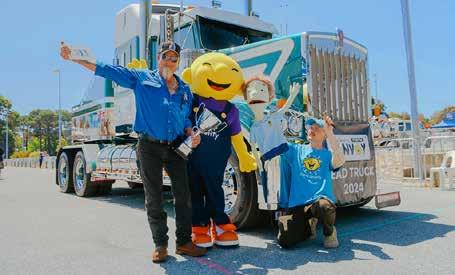

an opportunity for families to reconnect and share their experiences they face with others in a similar situation.
Camp Quality Kids’ Camps give children impacted by cancer, whether their own diagnosis or that of a family member, the opportunity to make new friends who understand what they are going through, enjoy some laughs and make happy childhood memories.
All programs are facilitated by a team of passionate volunteers, who help create a safe and supported environment.
For families like Abby’s, Camp Quality programs shone light during dark times. Abby, now 8, was diagnosed with leukaemia in February 2022 when she was just five. Her mum, Cassie, recalls how cancer flipped their lives upside down, with endless rounds of chemotherapy and hospital stays becoming the new normal.
After registering with Camp Quality, Abby and her family attended their first Family Camp, which gave them the chance to be together again outside of hospital
“Camp Quality has brought fun back into our lives,” she says. "It has been the best thing for our family.”
Convoy participants will raise money to help the thousands of families like Abby’s. $50,000 can fund a Kids’ Camp for around 50 kids, while $30,000 provides a Family Camp for 20 families impacted by cancer.
The Convoy is open to prime movers without trailers, cement mixers, and small-tomedium sized trucks. If you want to participate with anything bigger, contact the event organisers to check if your vehicle is suitable.
All entrants will have their own online fundraising page to receive donations, and access rewards for top fundraisers. The highest fundraiser will be announced as the

Lead Truck at 3pm on Saturday, 11 October, receiving the honour of leading the Convoy.
The Convoy Perth Family Festival is a FREE community event, packed with fun for all ages, including A food vans, rides, face painting, roving entertainment, live music, fundraising awards and of course the opportunity to cheer on the returning Convoy and check out all the trucks and vehicles at the ‘Show and Shine’ after the Convoy returns.
Register your truck for Convoy Perth online by visiting www.convoy.org.au. Truck registrations close on Monday, 6 October 2025 at 10am – unless sold out prior.
If you have multiple trucks at your company or within your area, you can form a team to combine your fundraising efforts.
Registration fees for the Convoy Perth are $40, plus a commitment to donate at least an $55 to Camp Quality (taxdeductible donation receipts available).
For more details, including the course and venue map, event timings and to request a participant information pack, visit www. convoy.org.au or contact Elle Mazza at Camp Quality WA. Email convoy@campquality.org.au or call 08 6163 5611.
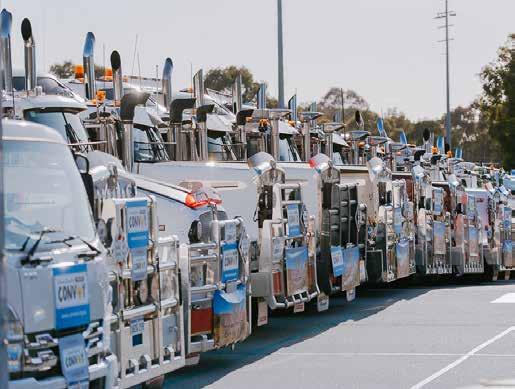

Date: Sunday 12 October 2025
Depart: Perth Hockey Stadium at approximately 10am
Return: Perth Hockey Stadium at approximately 11am
Event fun: The Family Festival will run from 10:30am – 2:30pm at Perth Hockey Stadium
Register your truck at www.convoy.org.au by Monday 29 September

PUBLISHER / COMMISSIONING EDITOR
Karen-Maree’ Kaye
T: 0430 153 273
Email: karen@angrychicken.com.au
WRITERS
Karen-Maree' Kaye, Russell McKinnon
CONTRIBUTORS
Jan Cooper, Cam Dumesny, Cliff Graham, Carol Messenger, Ray Pratt
ADVERTISING ENQUIRIES
Angry Chicken Head Office
T: 0430 153 273
E: karen@angrychicken.com.au
DESIGN / PREPRESS
Cally Browning | Bare Creative
ACCOUNTS
T: 0430 153 273
E: accounts@angrychicken.com.au
PRINTER Daniels Printing Craftsmen
SUBSCRIPTIONS
Subscriptions available directly from the Publisher.
T: 0430 153 273
E: karen@angrychicken.com.au
Australia: 1 year $130 (inc GST )
Overseas subscribers: Airmail postage will be added to subscription rate.
Editorial Submissions: The Publisher welcomes editorial submissions. Once received they will become the property of the Publisher who reserves the right to edit the or adjust the content to fit with the format of our publication.
West Australian Transport Magazine (WATM) is published by Angry Chicken Publishing Pty Ltd
ABN: 35 486 530 095 All rights reserved. No part of this publication may be reproduced, adapted or transmitted in any form by any process (graphic, electronic, mechanical or storage and retrieval system) or sold, resold or otherwise exploited for any purpose without consent of the Publisher.
The publisher, contributors, editors and consultants disclaim any and all liability and responsibility to any person or party, be they a purchaser, reader, advertiser or consumer of this publication in regards to consequences and outcomes of anything done or omitted, or being in reliance whether partly or solely on the contents of this publication. No person, organization or party should rely on or on any way act upon any part of the contents of this magazine without first obtaining the advice of a fully qualified person. The Publisher shall have no responsibility for any action or omission by contributor, consultant, editor or related party for content within WATM. The opinions and content within WATM does not necessarily reflect those of the Publisher, editor or their agents. No responsibility is accepted for damage or loss of material supplied to the publisher.

Awarm welcome to our new columnist Amber Wright. You would have read about Amber in the last edition, an amazing lady who is passionate about our industry. Amber is one of the many ladies in our industry who has shown that women are up for the job of driving heavy vehicles and performing the day-to-day jobs that are required to keep them on the road. Amber fosters a positive voice for industry where we at all levels must work ‘together’ to make changes and improvements that are needed.
In this edition, the word ‘productivity’ has popped up many times and it surprises me that we are only just talking about this now. Perhaps a return to productivity will make decision makers look more carefully at what they have put in place to hinder the transport industry – much in the name of safety… but many question is this industry any safer? The loss of life that we hear about regularly, does not seem to back this up.
WA Transport Magazine is proud to again support the Camp Quality Convoy Perth, so head over to page 3 for all the details on how to attend this year. The WA transport industry made a huge amount of money last year for the kids and their families facing cancer and it would be great to make it bigger and better this year.
Lots in this edition including all the findings on Operation Twilight – a joint road transport compliance initiative involving Main Roads WA, the WA Police Force, and NHVR in the Eucla in May.
We also talk about the cutting-edge safety cameras that will be deployed around Western Australia and our ‘This is the Outback’ columnist Cliff Graham brings up some interesting points on Page 19.
As always, thank you to everyone who supports our Western Australian transport magazine which is 31 years young.
Best,
sleep apnoea tests for truck
Every Month
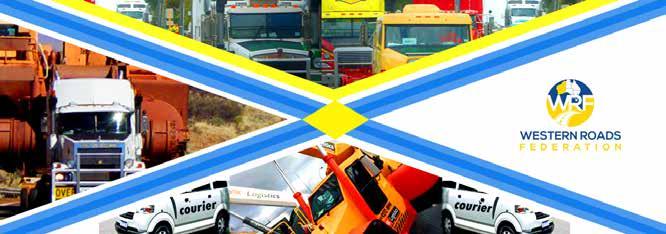
By AMBER WRIGHT Transport Industry Training Solutions

Amber started on the farm, licensed at 15 driving tractors and carting sheep. At Truckline she worked on brakes, learned how brake systems worked, serviced, adjusted and changed tyres and she had no idea how handy that would be through her 15-year career driving quads in the Pilbara and the Kimberly.

We the drivers are the ones who will change this industry for the better
Ihave been an avid reader of WA Transport Magazine and I’m absolutely thrilled to have been asked to add my two cents worth.
In last month’s edition there was a lovely write up about how I started off early in life driving trucks and being involved in the industry through family, friends and farming. I have been lucky to be part of what I’d consider the ‘old school’ - no cameras, trackers, or technology and no idea what I was doing - but giving it a red-hot go.
I had the support of old school drivers, men and women, who would roll their eyes at me doing something dumb and say, “Hey mate, are you ok?” or, “What are you doing?”
I am grateful I got through my first few years of learning and stuff ups - of which there were plenty. Out of necessity, I learned how to do the hard things but I was afforded the opportunity to learn ‘without judgement’, forging lifelong relationships with good people who wanted nothing but to see me be better and do better.
How times and attitudes have changed.
Social media is now the way everyone connects and it’s a dog-eat-dog competition on everyone else’s business.
In my time, I have been verbally and physically assaulted by fellow drivers, supervisors and strangers - but I could always walk away, take time to shake it off and move on.
Social Media means your ‘bully’ lives in your pocket and people have 24/7 access to you if you let them. It’s terrifying to think our kids go through this.
You want to have a go but someone always has an opinion, good or bad, and it stops a lot of really passionate people sharing their amazing stories and ideas and
talking about the industry they love.
There is also the ‘not my problem’, typical &$%#’s.
There is a skills gap, and a hole in licensing system that is starting to close but that closure was paid for in blood by some of our newest and oldest brothers of the road.
Fingers can be pointed at what part of the industry is to blame - RTO’s, DOT or industry itself - but nothing will change without years of hard slog from those who take on the challenge.
I read about how many issues we have - sexism, racism, ageism, skills gap in training, poor quality training and the bloody toilet situation and I think, who the hell would want to drive a truck now?
We all want the industry to be better but we are the only ones who will change it –us, the drivers, the boots on the ground.
We need to do more at a grassroots level and be the change you want to see. So, try saying, “Hey mate”, next time you
meet someone.
If they are thriving be happy for them and their successes won’t make yours look any less shiny. If they are struggling – help them.
You don’t know what you don’t know and wouldn’t you rather they learned from someone who does know than hope they get away with it and no one gets hurt?
Walk up and say, “Hey mate”. It might make them more receptive to advice when coming from a place of mentorship and not a place of judgment. You may be told where to stick it; but they might just surprise you too and you may even save a life in the process.
We all need to start treating each other the way we want to be treated, with basic dignity, mateship, laughter and support. No-one is perfect in this industry so don’t gatekeep the invaluable knowledge and experience you have - because it’s what’s going to keep us, your family and the industry alive.
Next time you see me, come and say, “Hey mate”.
I had the support of old school drivers, men and women, who would roll their eyes at me doing something dumb and say, “Hey mate, are you ok?” or, “What are you doing?”


Cutting-edge safety cameras that can detect mobile phone and seatbelt offences will soon be appearing on Great Southern roads.
Two safety camera trailers will be set up in Albany and rotate around the Great Southern region as part of the next phase of the State Government's safety camera rollout.
These new safety cameras are the most advanced in the nation and have the capability of detecting multiple offences simultaneously, including speeding, illegal mobile phone use, and the improper use of a seatbelt.
They can also be deployed to detect towed and heavy vehicles limited to 100km/h speed limits as well as spot and
opportunity to change their behaviour before enforcement commences.
The next phase of the safety camera rollout will see two of the safety camera trailers based in Geraldton and deployed across the Mid West region.
The safety camera program is funded through the Road Trauma Trust Account, which sees 100 per cent of safety camera infringements allocated to projects and programs which reduce injuries and deaths on Western Australian roads.
point to point average speed.
Four safety camera trailers operating in the Perth metropolitan area and fixed cameras on the Kwinana Freeway detected nearly 107,000 mobile phone and seatbelt offences since January.
From 10 June, the Road Safety Commission will issue caution notices to drivers in the Great Southern region detected committing a mobile phone or seatbelt offence by the safety camera trailers.
The purpose of a caution notice period is to inform the community about the capabilities of the new type of safety camera technology, to educate about the dangers of distracted driving and not wearing a seatbelt, and to give drivers an
The Fair Work Commission has handed down the 2025 Annual Wage Review Decision and the National Minimum Wage and all Modern Award classifications will increase by 3.5%.
The new National Minimum Wage is $948.00 which equates to an hourly rate of $24.95 per hour for employees employed on a permanent full time or part time basis and a casual rate of $31.19 per hour. In hourly rate terms the increase is $0.85 cents per hour for permanent adult employees and $1.06 for casual employees.
The increase must also be applied to each wage classification in each Modern Award and as such, the amount of the increase may vary even within the same Modern Award. The increase in wages will
flow on to employees that are less than 21 years of age proportionally depending on the junior worker provisions that are relevant to those employees.
Further information will become available in relation to the new Award rates closer to implementation date when the FWC had made the necessary adjustments to the Modern Awards.
Employers paying employees above Award rates may offset the increase subject to certain other requirements being met.
The increase has effect for most Modern Awards from the first full pay period commencing on or after 1 July 2025. Superannuation Changes Employers are also reminded that from
Police and Road Safety Minister Reece Whitby said, "Regional drivers are overrepresented in serious crashes and the rollout of these safety cameras is about saving lives.
“This cutting-edge technology has been successful in the Perth metropolitan area and now dangerous drivers are being put on notice across regional WA.
Road Safety Commissioner Adrian Warner said, “Regional road fatalities represented 60 per cent of the road toll in 2024 with three in every four serious crashes on regional WA roads involving a local driver either within their own local government area or an adjacent one.
“Camera locations are guided by crash data and advice from the WA Police Force and Main Roads Western Australia to ensure a wide spread of geographical deterrence.”
By GRAHAM LILLEYMAN Employment Services and Solutions Australia
1 July 2025, compulsory employer funded superannuation will increase from 11.5% to 12%.
Employers are reminded that they are legally obliged to comply with minimum wage and/or Award obligations and there are severe penalties for non-compliance.
Employers using enterprise bargaining agreements should have their arrangements reviewed, because whilst Modern Awards do not generally have application to businesses that have Agreements, the base rates of pay under Agreements must comply with your obligations under section 206 of the Fair Work Act 2009
The Department of Transport (DoT) will trial extended weekday trading hours at three Driver and Vehicle Services (DVS) centres for 8 weeks from 30 June until 29 August 2025.
Cannington, City West and Mirrabooka DVS centres will open for all DoT transactions between 7.15am and 5.30pm weekdays.
The extended weekday trading hours trial follows the successful Saturday blitzes at the same three DVS centres that saw around 12,800 people visit Cannington, City West or Mirrabooka.
DVS centres have experienced high demand for services in the past two years, with staff conducting 2,036,396 transactions and assessments in 2023-24, resulting in longer wait times. Last year, DoT created 43 new positions in metropolitan service centres to increase its capacity to meet the growth in demand.
A high level of interstate and
international migration into WA has increased demand for DoT's general licensing services.
All other metro DVS centres will open for usual trading hours between 8.15am and 4.30pm during the extended weekday trading hours trial.
Once the trial has concluded, DoT will evaluate staff and customer sentiment and feedback to measure the success of extended weekday trading.
Minister Assisting the Transport Minister Jessica Stojkovski said, "This trial of extended weekday trading hours is a positive step towards improving the customer experience at the Department of Transport's Driver and Vehicle Service (DVS) centres.
“In addition to increasing the number
of staff on front counters, the Cook Government is working to improve accessibility to DoT's services for the community, such as extending weekday trading hours to enable people to visit a DVS centre before or after work and school.
“The Cook Government will continue to explore further options to reduce customer wait times, to reduce travel and wait times and ease pressure on DVS centre staff during times of high demand for services."
Cannington MLA Ron Sao said, "This is an important initiative for drivers, reducing wait times so they can get back on the road and doing the things that are important.
“I encourage anyone who struggles with finding the time in the day to do life admin to take advantage of these extended hours.”





premier brake and clutch




From major truck workshops, heavy haulage, cranes, the mining industry and more… our team of knowledgeable and qualified technicians share over 100 years combined experience and focus on delivering prompt service alongside the supply of top name brakes and clutchesthroughout Australia and Asia.
With over 20 years in the industry we have a well-earned reputation for the development, manufacture and supply of quality standard and customised designs to suit a wide range of applications.
For the best advice and friendly service contact us today.
+61 8 9353 4411 ■ sales@knightbrakeandclutch.com.au knightbrakeandclutch.com.au

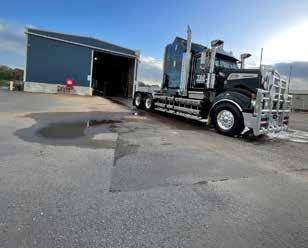


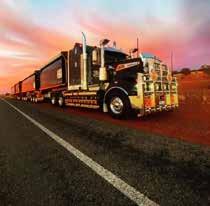


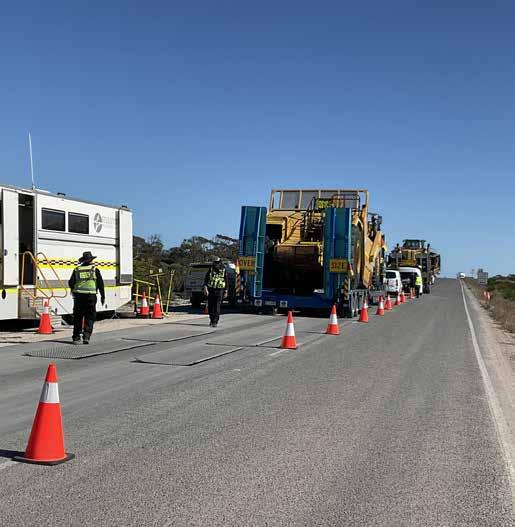
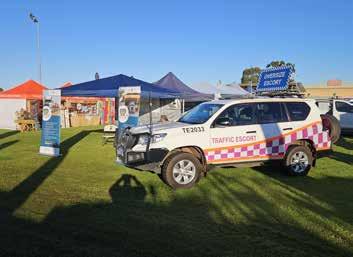
Operation Twilight took place from 1 to 10 May 2025 as a joint road transport compliance initiative involving Main Roads WA, the WA Police Force, and the National Heavy Vehicle Regulator’s (NHVR) South Australian Operation Compass.
The Operation was delivered in two distinct phases:
Phase One 1 - 6 May: Marked Compliance patrol vehicles conducted highway patrols and operational roadblocks across key freight routes between Perth, Kalgoorlie, Esperance, and towards Eucla, focusing on compliance, road safety, and proactive engagement with industry.
Phase Two 7 - 10 May: The second phase was staged at the WA/SA border and operated on a 24-hour, non-stop schedule for four consecutive days. This enabled patrol intercepts and inspection of all heavy vehicle movements crossing the border in either direction, ensuring full compliance
with mass, dimension, mechanical safety, load restraint, and compulsory accreditation requirements.
This coordinated operation demonstrated a strong, collaborative effort to uphold safety and compliance across State borders while supporting national transport safety objectives.
Main Roads WA Transport Inspectors carried out detailed inspections of heavy vehicles using Weigh-in-Motion systems and Mobile Vehicle Inspection trailer units. These assessments focused on ensuring compliance with mass, dimension, load restraint, mechanical safety, and Western Australia's Heavy Vehicle Accreditation Scheme (WAHVA) requirements.
WA Police performed highway patrol duties, enforcing speed regulations and conducting alcohol and drug testing of heavy vehicle drivers where necessary.
This joint operation demonstrated a
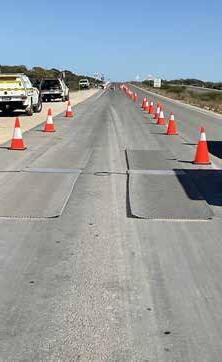
strong commitment to enhancing road safety, lifting compliance standards, and contributing to national transport safety outcomes across jurisdictions.
The Officer-in-Charge of Eucla Police Station, who attended the four-day road policing and heavy vehicle operation at the Eyre Highway border post, commented, “It was a great example of a joint operational focus supporting both State and national road safety outcomes, something the WA Police Force strongly supports.”
Michael Buba, Director of Main Roads Heavy Vehicle Services, emphasised the importance of collaboration in delivering strong compliance outcomes.
“Partnering with transport regulators and road safety agencies is a core objective of Heavy Vehicle Services. The significant resource commitment to this 10-day operation clearly demonstrates to both the community and the transport industry that our team is deeply committed to upholding compliance and road safety for all operators entering or leaving Western Australia.”
“Sharing information and working closely with the NHVR has become an integral part of our operations. This integrated approach is driving better and safer outcomes across the national transport network, supporting compliant and responsible operators using the WA road system.”
During Operation Twilight, Heavy Vehicle Compliance intercepted 238 heavy vehicles, conducted 105 vehicle combination weight assessments, and issued 123 compliance-related offences..
During March and April, Main Roads Heavy Vehicle Services attended the Caravan and Camping Show in Perth and the Harvey Show in the South West Region.
These events were fantastic opportunities for us to engage with the WA community and share important tips on safely interacting with heavy vehicles on our roads. Our booths drew in many visitors. The Traffic Escort Warden and Road Transport Compliance Inspector vehicles were a big hit, sparking lots of curiosity about what we do.
We distributed loads of brochures and educational items. The ability to connect directly with the WA community about heavy vehicle safety on WA roads is always a highlight for HVS representatives.
The Harvey Show stood out with the number and variety of questions about interacting with Over Size Over Mass (OSOM) loads under Traffic Escort. We also had queries about Heavy Vehicle Licenced Pilots, roadworks, and Heavy Vehicle Permits. It was great to see so
much interest in how HVS ensures the safe passage of oversize vehicles and loads. The feedback was overwhelmingly positive, with many visitors appreciating the engagement and detailed advice from our representatives.
HVS would like to acknowledge the support our regional colleagues provide in enabling us to participate in these events.
If you are planning on attending any of the following, please visit our booth and say hello.
The WA State Government has committed $4 million to establish a new Driver and Vehicle Services (DVS) centre in the Armadale/Byford area, delivering a 2025 election commitment.
The funding, allocated in the 2025-26 State Budget, will provide for consultation, planning, design and delivery of the new community asset.
The services on offer at the new centre will include:
• learner’s permit and WA photocard applications;
• theory and hazard perception tests;
• practical driving assessments (PDAs);
• interstate and overseas driver’s licence transfers;
• vehicle and boat registrations and transfers; and
• custom plates.
Currently, the Department of Transport’s (DoT) Cannington and Success DVS centres service customers from the south-eastern corridor, with around one in five people driving up to 40 minutes to attend those centres from the City of Armadale, City of Gosnells or the Shire of Serpentine-Jarrahdale.
Community and stakeholder consultation will be undertaken to determine a location that will best accommodate customers and provide better access to DoT services for southeastern metro residents and reduce customer numbers and wait times at other centres.
This Budget follows efforts to improve services, including the new Department of Transport centres at Butler and Busselton, the dedicated driver assessment centre at Joondalup, Saturday and extended opening
hour trials at DVS centres, and recruitment of extra driving assessors and staff.
The Minister Assisting the Transport Minister Jessica Stojkovski said, “The Department of Transport has recently experienced rapid growth in demand for its services, particularly in the thriving southeast metro region, which is putting pressure on existing DVS centres and increasing wait times for customers.
“The Cook Government’s election commitment of a new licensing centre in the Armadale/Byford area will provide better access to DoT services, much closer to home for those residents currently driving 30 to 40 minutes to attend another centre such as Cannington or Success.
“DoT will consult with the community and key stakeholders to determine the location that best serves the needs of customers in the south-eastern suburbs.”
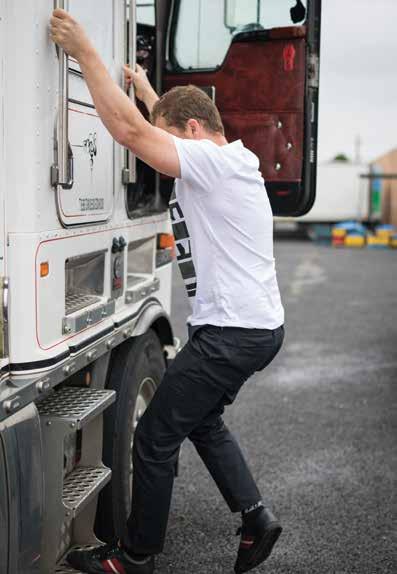
’ve often talked about Owner Drivers and the enthusiasm they bring to the industry. This is evident in the way that they look after their trucks, their dedication to the job in the way they load the freight and look after it during its journey. Even though most of us have families I’ve often said that being an Owner Driver - we became married to the job. Keeping the wheels turning was what paid the bills and everything else took second place.
For decades, truck drivers have been the unsung heroes of the economy, spending long hours on the road to ensure that goods reached customers and businesses across the nation.
Many drivers were drawn to the job by a sense of freedom, pride and a deep commitment to their work. Trucking was not just a job—it was a lifestyle, and for many, a calling. However, over time that sense of purpose and enthusiasm has waned. Today, the trucking industry faces a troubling decline in standards, driven by burnout, exploitation, and a generational shift in attitudes toward the profession.
In my earlier days of trucking, drivers took immense pride in their role. The job offered independence, decent pay, and a sense of adventure. We often speak nostalgically about a time when there was camaraderie among drivers, mutual respect from employers, and a stronger social appreciation for their contributions. Unfortunately, as the industry evolved so did the nature of the
To reverse this trend, industry leaders must recognize that truck drivers are not expendable
work—and not for the better.
Many trucking companies became driven by greed and the pressure to cut costs and increase efficiency. What was once a proud career became a high-stress occupation. Drivers faced unrealistic delivery schedules, longer hours on the road, and more time away from their families. Pay stagnated for many, especially when factoring in the time and expenses absorbed during unpaid hours like loading, unloading, or waiting time. Many time’s efforts were made to get proper recovery of our costs only to be told if you didn’t like it, you know where the gate is. Health and safety took a back seat to profit margins. As a result, a once-enthusiastic workforce began to feel used and undervalued.
Burnout became rampant. Long hours behind the wheel – often with little sleep and poor die – took a toll not just physically but mentally. The sense of pride that once defined the profession was replaced by frustration and exhaustion. Seasoned drivers, many of whom had dedicated their entire working lives to the industry, began leaving in large numbers, either retiring early or switching to less demanding jobs. As these experienced professionals exited, they took with them a wealth of knowledge, skill, and a culture of dedication that had long underpinned the profession.
The new generation entering the field faces a different reality. While some enter the industry with good intentions, they often lack the same passion and endurance of their predecessors – not necessarily by choice, but because the system has failed to inspire it. With fewer mentors and deteriorating working conditions, new drivers are thrust into a high-pressure environment without the guidance or support needed to develop a strong professional identity. The result is high turnover, lower morale, and a widespread perception of trucking as a “last resort” job rather than a career.
Moreover, technological changes and increased regulation— though often necessary—have further stripped away the sense of freedom that once defined the job. Electronic logging devices, tighter delivery windows, and corporate micromanagement have left drivers feeling more like cogs in a machine than skilled professionals. While safety and efficiency are important, the human element of trucking has been largely ignored.
The consequences of this shift are serious. A workforce without passion or commitment leads to lower service quality, safety concerns, and logistical inefficiencies. The industry struggles to recruit and retain talent, and consumer goods face increasing delays as a result. Without meaningful changes, the decline will only continue.
To reverse this trend, industry leaders must recognize that truck drivers are not expendable. They are critical to the fabric of the economy. Restoring dignity and purpose to the profession requires better pay, humane working hours, stronger mental health support, and a culture that respects and values drivers’ contributions. If we can bring pride and passion back to the driver’s seat, the industry might once again roll forward with strength and purpose.
Is anyone listening?
Keep it safe, Ray Pratt.
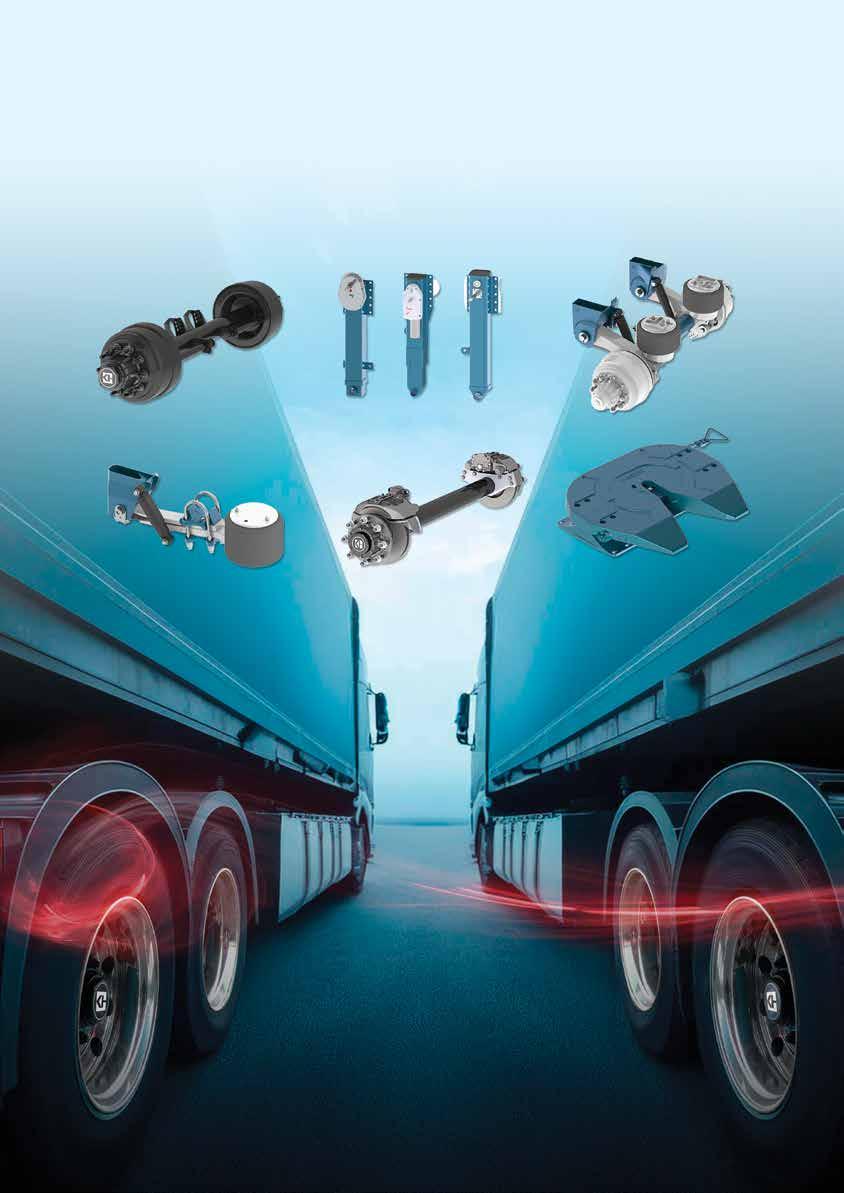

Boosting truck productivity would reduce costs for families and support higher real wages says Australian Trucking Association (ATA) Chair Mark Parry.
The ATA was responding to the Productivity Commission’s initial consultations on five productivity inquiries.
Mark said that increasing access for longer truck combinations could reduce the industry’s operating costs by $13.6 billion over the years to 2050 and save households more than $400 per year on their everyday purchases.
“Increasing productivity is the key to reducing the cost of living for families now and increasing real wages in the long term. It is also the key to reducing costs for our exporters,” he said.
“Australia’s governments are working to create an automated access system to replace nine out of ten road access permit applications, but it is not clear when the system will be finished.
“The ATA’s response argues that the Government should strongly encourage the participating states to roll out the system faster and to publish timeframes for each component.
“Australian Government funding should be available to assist governments that are still reviewing the state of their roads and bridges.
“The ATA has called for a $5 billion, ten-year program of targeted road upgrades
to expand the roads that can be used by high productivity trucks, as well as battery and hydrogen electric trucks. These trucks are heavier than conventional trucks. They cannot carry the same amount of freight unless their gross mass is allowed to be higher.
“The road upgrade funding should also be used to increase the resilience of the road system.”
Mark said the Government needed to take action to build the industry’s workforce.
“The Australian Government provides financial support to some apprentices, but it does not support apprentice truck drivers. That needs to change,” he said.
Mark said the ATA’s plan to reduce the industry’s emissions would save more than 35 million tonnes of CO2 over 25 years.
“These measures would deliver 9.3 per cent reduction in total cumulative emissions over 25 years compared to the base case in the Deloitte Access Economics modelling we provided the commission,” he said.
The Australian Government will hold a growth and productivity summit in August, Prime Minister Anthony Albanese told the National Press Club.
“I have asked the Treasurer, Jim Chalmers, to convene a roundtable to
Based on ABS survey data there were an estimated 60 000 independent contractors in the road transport industry in 2024, with close to half working in road freight transport. The industry is male-dominated and road freight transport workers are older on average than the average labour force participant, while postal and courier pick-up and delivery drivers are younger on average.
Road transport contractors were more likely than employees in the industry to report working more than 50 hours in a week and to work six or seven days a week. The difference was greater relative to the total workforce.
Median earnings for full-time road transport contractors were estimated to be similar to the median for both employees in the industry and employees in the whole workforce, though mean earnings were lower.
Road passenger transport contractors had relatively higher earnings than the industry average, while postal and courier pick-up and delivery services contractors had lower earnings.
The rate of truck crashes increased every year from 2021 to 2023 (the most recent year of data), although owner driver vehicle crash rates did not increase over the period.
The trend rate of fatal heavy truck crashes declined in the 10 years to 2024.
support and shape our government’s growth and productivity agenda,” the Prime Minister said.
“At Parliament House in August, we will bring together a group of leaders from the business community, the union movement and civil society.
“This will be a more streamlined dialogue than the Jobs and Skills Summit, dealing with a more targeted set of issues.
“We want to build the broadest possible base of support for further economic reform,” he said.
The State Budget will target some of the worst congestion hot spots in Perth’s northern and southern suburbs.
For the northern suburbs, $113.4 million has been allocated across a range of projects with an initial $70 million allocation towards a new grade-separated intersection at Erindale Road and Reid Highway.
Works are scheduled to begin on the grade-separated interchange in 2028-29, with the State Government to allocate a total of $225 million towards the project. A matching contribution of $225 million has been committed by the Commonwealth Government for the project.
The intersection is rated as the worst in the State for congestion, costing the Western Australian economy $21.3 million in 2023-24, with the number of vehicles moving through the intersection each day increasing by around 10 per cent since 2019. Current daily traffic volumes are expected to increase from 60,000 to 111,000 by 2054.
Reid Highway is a critical east-west corridor for the northern suburbs, and the Reid Highway and Erindale Road interchange is the last at-grade intersection between Mitchell Freeway and Tonkin Highway.
Perth’s northern roads package also includes a $35.9 million program of works to deliver a range of intersection improvements along Wanneroo Road, including:
• Warwick Road - additional right turn lane on Wanneroo Road, left turn lane modifications on Wanneroo Road, and turn lane extensions;
• Hepburn Avenue - widening the median of Hepburn Avenue to enable a double right turn. Median widening on Wanneroo Road to enable double right turn from Wanneroo Road northbound to Hepburn Avenue westbound;
• Gnangara Road - advanced detector loops to improve queue detection and signal optimisation;
• East Road - realigning Wanneroo Road southbound carriageway further to the west, to bring forward to the give way line on East Road to improve sight lines; and
• Whitfords Avenue to Gnangara Road connection - planning to complete concept design work for the future Whitfords Avenue-Wanneroo Road-Gnangara Road interchange.
A total of $485.5 million has been allocated to deliver upgrades on four key roads in Perth’s southern suburbs including $460 million to widen Kwinana Freeway between Roe Highway and Mortimer Road - addressing one of the worst congestion points on the freeway network.
The State and Federal Government are each committing $350 million towards the $700 million Kwinana Freeway project.
The Kwinana Freeway between Russell Road and Mortimer Road carries some 100,000 vehicles per day, with up to 15 per cent being heavy freight vehicles.
The investment will add around 50 per cent capacity to the upgraded sections of the Kwinana Freeway, where congestion continues to create frustration for motorists and reduce the efficient movement of freight.
Works to widen the Kwinana Freeway are expected to start in 2026/27, with the upgrades to include:
• an additional lane in both directions between Russell Road
and Mortimer Road, taking the section of freeway from two lanes to three;
• an additional lane southbound between Roe Highway and Berrigan Drive taking the section of freeway from four lanes to five;
• an additional lane northbound from Russell Road to Beeliar Drive taking the section of freeway from three lanes to four; and
• addition of co-ordinated ramp signals between Safety Bay Road and Roe Highway to improve flow of traffic on the freeway.
Other key election commitments being funded to be delivered under the State Budget include:
• $17 million to build roundabouts at the intersections of Kargotich Road with Abernethy Road, Orton Road and Gossage Road, supporting the growth of Byford and Mundijong (project to be delivered by the Shire of Serpentine-Jarrahdale);
• $7 million to deliver upgrades to the Baldivis Road and Kulija Road intersection including new traffic signals and an additional westbound through lane on Kulija Road to avoid queues back to the freeway interchange in the morning peak periods (project to be delivered by the City of Rockingham); and
• a $1.5 million contribution towards the upgrade of the intersection of Nicholson Road and Warton Road (to be delivered by the City of Gosnells).
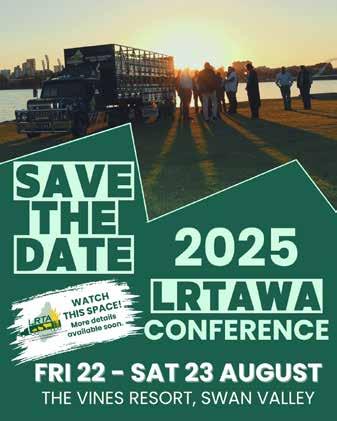
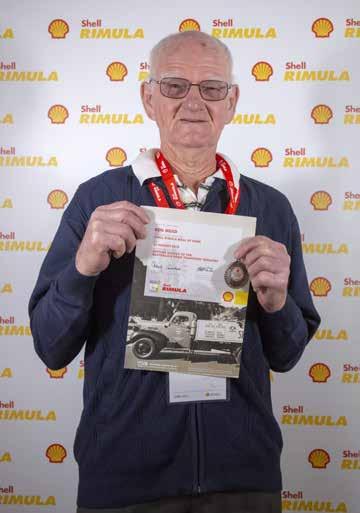
He purchased his first truck in 1958 - a five tonne AR 162, followed in 1960 by an International 162AA
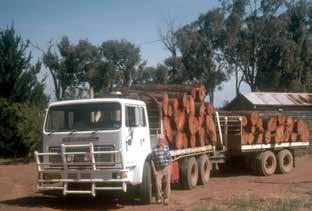
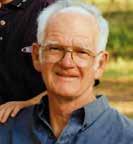
Ken Mead was born in Narembeen, Western Australia in 1938, but grew up in Chowerup where his father farmed and drove the district school bus.
In 1954 Ken began driving an International L162 carting short logs for the local timber mill. He purchased his first truck in 1958 - a five tonne AR 162, followed in 1960 by an International 162AA.
In 1974 Ken managed the local timber mill and bought a 1967 Commer CC. He upgraded in 1980 to a C1900 International, with VT190 V8 Cummins engine, and tip trays.
In 1984 Ken purchased a 1982 M112 Scania and 40ft trailer, and his love of driving and trucks was realised. He rebuilt the engine himself and the truck was well
known in the district; the kids loved it. Ken carted wool to Perth and returned with general freight. In 1988, Ken and his son purchased a small business which included a 1979 UD.
In the early 1990’s Ken travelled between Western Australia and Victoria carting farm machinery. Over the next 20 years several more Scania’s were purchased. Loads were typically wool, grain, sheep and cattle and sometimes included deer and grapes.
In 1997, driving a Scania H144 Ken and his wife Peggy, travelled weekly from WA to Brisbane carting farm machinery to the east and returning with general. One unusual load was two date palms from Adelaide to the Gold Coast. One memorable trip
was driving a road train around Australia in 2000, leaving from Boyup Brook and going to Townsville, via Adelaide and Brisbane. Then to Karratha via Mt Isa, Katherine and Kununurra, then to Perth, back to Karratha again, and lastly home. It was a momentous trip, dealing with floods and all the north of Australia can throw at you.
In 2018, although he no longer had his trucking business Ken was not ready to retire. Whether co-driving, picking up new trucks from the East or driving for a few mates locally he took any opportunity to get behind the wheel or could be found tinkering with engines or restoring his 1950’s Fordson tractor.
Professionalism in agriculture means following best practice – sustaining the land for future generations, caring for livestock and crops, and ensuring operations remain economically sound. For many of us, this has been a way of life for generations but increasingly, that is no longer enough,” says Executive Director of the ALRTA Anthony Boyle.
“We now live in an era governed by what I call “the court of public opinion” –often referred to as ‘social licence.’ This is now one of the greatest deciding factors in whether we can continue doing what we do. And the implications for our industry are profound.
The Live Sheep Export Ban is a warning
Labor’s recent election result and their mandate to end live sheep exports confirmed what many of us feared; a wellfunded, emotionally charged campaign can dismantle an entire industry — despite best practice, regulation and science. Not even the human face of the industry was enough.
This is not about correcting poor welfare standards. It is the result of a deliberate strategy executed by groups determined to reshape the country according to their own values. And now, buoyed by their success, they’ll continue louder, stronger, and more energised.
Who are the people who get to decide what’s acceptable? The inner-city voters watching viral videos or the suburban families voting with their wallets or the foreign consumers disconnected from our climate, costs or compliance standards?
“Increasingly, it’s not farmers, transporters, processors, scientists or regulators who get the final say – it’s the squeakiest wheel that gets the oil.
“Activist groups don’t need to be right –they just need to be loud, emotive and visually compelling. Science and economics move slowly. Outrage and social media do not.
“Some in the sector saw the end of live sheep exports as a necessary sacrifice – a trade-off to satisfy public sentiment. But history tells us that giving an inch only leads to losing a country mile.
“Already under fire are long-haul
It is the result of a deliberate strategy executed by groups determined to reshape the country according to their own values
livestock transport, Feedlotting and meat processing, Intensive cropping practices and even mining and freight – the very systems that underpin our economy. This isn’t reform – it’s death by a thousand cuts.
Anthony says, “What happens next is up to us. Being compliant, ethical and right isn’t enough. We must be visible, united, and strategic and take back the narrative showcasing our professionalism, care and science and educate the public before misinformation fills the void.
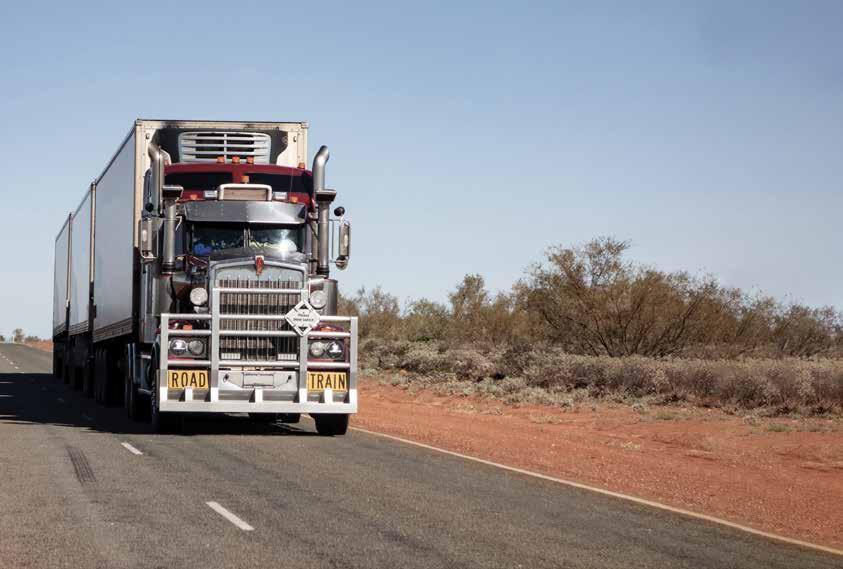


By LUKE OLSEN Managing Director APAC, Microlise
Heavy vehicle crashes are on the rise, and it’s not hard to see why. With more trucks on the road than ever before, driven by booming freight demand and pressure to meet tighter delivery windows, the risks are increasing.
The Australian Government’s Safer Local Roads and Infrastructure Program (SLRIP) is a welcome step forward, with $200 million committed annually to improving road conditions and rest stop infrastructure. Since applications opened in 2023, several projects have already received funding.
But safer roads alone won’t solve the problem.
To truly shift the dial on road safety, we need to pair infrastructure investment with smarter in-vehicle and planning technology. Telematics and real-time safety tools provide the visibility operators need to reduce risk, support their drivers, and meet their Chain of Responsibility obligations.
Smarter route planning, better data, and reduced pressure on drivers. These are the levers that will help deliver safer outcomes across the industry.
The key challenges organisations face in improving safety
Driver safety is a constant balancing act. Fatigue management is a major challenge, ensuring drivers remain compliant with fatigue regulations and aren’t pushed to breach hours to meet tight SLAs.
Distraction is another rising concern, with mobile phone use and even eating or drinking while driving posing serious risks, yet often going undetected without the right technology. Speed compliance also creates headaches, especially as frequent speeding infringements or mobile phone use can cost a driver their licence and worsen the existing driver shortage. Without visibility, businesses are flying blind on safety.
Technology gives operators the visibility and tools to actively monitor and improve driving behaviour. We’ve seen fleets reduce overspeed events significantly, while safety cameras and driver distraction alerts can instantly intervene to correct risky habits. In one case, deploying distractiondetection technology led to an 85% drop in distraction events, a direct link to reducing road incidents. When 65% of all road
Distraction is another rising concern, with mobile phone use and even eating or drinking while driving posing serious risks
accidents involve distraction, the safety and bottom-line ROI of smart telematics is crystal clear.
Advanced in-cab driver distraction monitoring plays a huge role. Instant alerts help drivers self-correct in real-time. Multicamera systems (up to four-way views) not only improve situational awareness but are invaluable for post-incident investigation, often exonerating drivers.
There are some really exciting and innovative technologies set to further improve driver safety over the next 5 – 10 years. AI is changing the game. We’re seeing a strong push across the industry, from OEMs to logistics providers, to embed AIpowered safety systems into vehicles. From
predictive risk detection to autonomous intervention, this isn’t just future-gazing; it’s already shaping procurement decisions. The next wave includes semi-autonomous safety interventions, predictive distraction scoring, and real-time driver coaching powered by AI.
Another major area is predictive maintenance. With the right data, operators can identify early warning signs of vehicle faults before they become dangerous or lead to breakdowns. Braking system wear, tyre pressure anomalies, engine issues, all can now be tracked and flagged in advance, reducing the risk of incidents caused by mechanical failure.
We’re also seeing innovation in driver safety monitoring (like fatigue detection via biometrics), advanced ADAS integration with telematics platforms, and the rise of V2X (Vehicle-to-Everything) connectivity, where vehicles can communicate with infrastructure, other vehicles, and even pedestrians to proactively avoid hazards. It’s a fast-evolving space, but one that’s set to make roads and our drivers significantly safer.
There are some fantastic examples of how fleet managers have improved safety by adopting telematics and other transport technology solutions. One of Australia’s largest retailers recently rolled out a Telematics and Driver Distraction detection solution across its fleet. During the initial rollout, distraction events dropped by more than 90%, creating a much safer environment for drivers and reducing the likelihood of incident-related downtime. Meanwhile, another major Australian retailer saw a 99% reduction in mobile phone use and a 95% reduction in unbelted driving.
Across other enterprise fleets, we’ve seen significant reductions in overspeeding and harsh braking, alongside fewer insurance claims and faster resolution of disputes, all thanks to better data and proactive safety management.
While there is still a long way to go, technology is playing a pivotal role in mitigating these risks and enhancing the safety of all road users.
The Australian Government should bulk bill overnight sleep apnoea tests for truck drivers and other safety critical workers, Australian Trucking Association Chair Mark Parry and TruckSafe Chair Paul Fellows said.
Mark and Paul were releasing the joint ATA and TruckSafe submission to the NTC’s review of health screening for commercial vehicle drivers.
The NTC is looking at expanding the commercial medical standards to include better screening for heart disease, diabetes and sleep disorders.
“The ATA has argued for many years that the commercial standards should include preventative screening for the key health
risks to road safety,” Mark said.
“A GP undertaking a commercial medical would work through the screening procedure and, if needed, refer the driver for specialist follow up,” he said.
The submission argues that one of the priority health risks for truck drivers is obstructive sleep apnoea, which can cause drivers to fall asleep behind the wheel.
“The case for acting on sleep apnoea is compelling. Our submission documents its toll of deaths, serious injuries and ruined lives,” Mark said.
“One of the barriers to addressing sleep apnoea, however, is the cost of confirming the diagnosis after a driver’s GP refers them to a specialist for investigation.
“The Government should offer incentives to encourage sleep clinics to bulk bill sleep studies for truck drivers and other safety critical workers. It should also fund a long term loan scheme for CPAP machines, similar to the one run by the New Zealand hospital system,” he said.
Paul said the changes needed to protect truck drivers’ jobs.
“The screening tests that we are talking about highlight if further investigation is needed. They are not diagnostic,” he said.
“That’s why AFTD needs to be amended so a driver who is referred to a specialist as a result of health screening can continue to drive unconditionally, provided they make an appointment to see the relevant specialist at the earliest practicable opportunity.”
Paul said there needed to be more information about high risk medical conditions and how to manage them.
“TruckSafe led the way on this by requiring our member companies to provide drivers with health information in the 1990s and 2000s. Our new TruckSafe safety management system has a sample worker health and wellbeing policy that requires the development and implementation of health management programs,” he said.
Mark said the changes should be supported by a nationwide campaign.
“Our submission recommends that the Government provide Healthy Heads in Trucks and Sheds with $1 million per year over four years to deliver 16,000 health screenings and distribute health awareness resources, including mental health resources, to 40,000 drivers,” he said.
The Motor Trades Association of Australia (MTAA) has expressed deep disappointment at the decision by the Australian Competition and Consumer Commission (ACCC) to approve Insurance Australia Group’s (IAG) acquisition of RACQ’s insurance operations.
MTAA Interim Executive Director Rod Camm slammed the approval as a dangerous step toward the concentration of Australia's insurance sector in the hands of a few dominant players, warning of dire consequences for consumers and businesses alike.
“This is an assault on competition,” Mr Camm said. “By handing over yet another iconic motoring brand to a corporate behemoth, the ACCC has effectively adversely altered structure in the Australian insurance sector. This decision will turbocharge market dominance, and leave Australians with fewer choices and higher costs.”
IAG announced a 20-year underwriting agreement with RAC
WA, a deal still subject to ACCC approval, which MTAA has strongly denounced as misleading for consumers and catastrophic for independent repairers.
“Consumers may continue to see trusted local brands, but the reality behind the scenes is a corporate takeover," Mr Camm said. “These arrangements ruthlessly strip decision-making away from locally accountable institutions and hand control to national corporate agendas that prioritise profits over people.’
The MTAA is sounding the alarm on the consequences of this unchecked consolidation, predicting crippling pressure on independent and family-run repairers, many of whom will struggle to survive and rroded service quality and vanishing consumer choice.
MTAA has also renewed its call for reforms to the Motor Vehicle Insurance and Repair Industry (MVIRI) Code of Conduct, including enforceable penalties and stronger ACCC oversight.
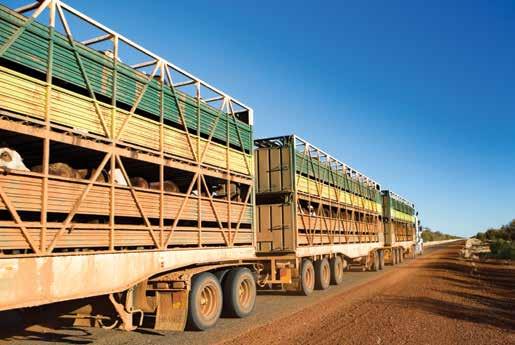
Meat and Livestock Australia has launched a Transport Hub – a central location for information and resources on transporting cattle, sheep and goats by road in Australia.
The hub follows extensive consultation in 2023 at transport industry events and brings together information specifically focused on best practice preparation of livestock through Australia’s red meat supply chain.
Information includes relevant standards
and guidelines, rules and regulations and there is a focus on presenting animals fit to load for their intended journey.
The Transport Hub is a work in progress; next steps involve the development of further extension and adoption resources to increase uptake of best practice preparation for livestock transport.
MLA welcomes feedback and suggestions which can be sent via email to transporthub@mla.com.au.
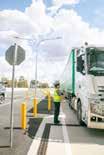
The NHVR concluded the third iteration of the National Roadworthiness Survey (NRS) in 2024. The survey ran for approximately 12 weeks across all Australian states and territories.
The 2024 NRS was the largest indepth health check ever conducted, with 9,082 vehicles and combinations inspected nationally.
The NRS provides a health check of Australia’s heavy vehicle fleet, letting the NHVR monitor the mechanical health of the heavy vehicle fleet and understand how compliant it is.
The information collected from the survey allows a determination of where the NHVR and industry are making improvements in vehicle safety, or where more focus may be needed. To read the full report visit www.nhvr.gov.au/files/media/ document/707/202504-1618-nrs-2024full-report.pdf.
The State Government has launched a pilot road safety education program targeting Year 7 and 8 students across regional Western Australia.
For the first time, Road Smart Kickstart, an interactive program using gamified learning stations, will be rolled out in country schools to help shape road behaviours early.
The Road Safety Commission's dedicated education team is gearing up for thousands of kilometres on the road as they bring this vital education directly to regional communities, recognising that 60 per cent of road fatalities occur on regional roads.
More than 55 sessions are already scheduled across schools in the Great Southern, South West, and Wheatbelt regions reaching an impressive 1,414 young people.
Developed with input from highly experienced education content provider Kimberlin Education, the program comes in 55-minute and 110-minute sessions focused on road safety awareness and decision-making skills.
The school visits will also include opportunities for schools to apply for road safety grants, with the object being to encourage creative local initiatives to make local communities safer.
These grants will vary from $500 'Power Up' grants for small school community centred projects to $5,000 'Change Master' grants available to schools for more comprehensive programs.
The new programs will complement the successful Road Safety Commission funded Keys4Life education program that allows
students over 15 to learn about safer driving and sit their Learner's Permit Theory Test. Police and Road Safety Minister Reece Whitby said, "It is so important to invest in our young people because safe driving attitudes can save lives.
"By the time they begin thinking about getting a driver's licence, many young people have already, often unknowingly, been shaped by the behaviours and attitudes they've observed in othersparticularly around speeding, distractions, seatbelt use, and peer pressure.
Education Minister Sabine Winton said, "It is crucial that all Western Australian students, including those in regional areas, learn how to drive safely on our roads and understand the consequences of reckless driving behaviours..
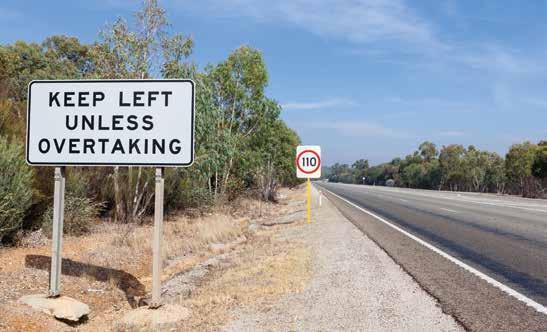
By Cliff Graham
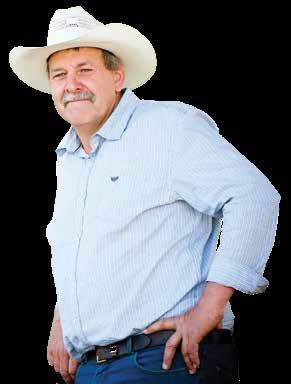
This month, I want to talk about the segment I listened to on ABC radio regarding the introduction six new safety camera trailers which are being used across the state.
The new safety cameras are the most advanced in the country and they can detect drivers who are not wearing or incorrectly wearing a seatbelt, using or holding a mobile phone while driving and speeding.
They are also capable of identifying heavy vehicles and vehicles towing trailers and caravans travelling faster than their maximum speed of 100km/h.
As I have mentioned many times before, nothing is as effective as Police presence on our roads but it comes down to placement.
Cameras whether mounted on trailers or speed cameras hiding behind bushes don’t catch dangerous or drunk drivers. In fact, I’ve never seen a speed camera situated on any dangerous sections of road.
Usually, the driver is unaware of any infringement until it’s delivered in the mail weeks later so ‘how’ is that stopping dangerous activities as they happen?
As we enter the winter months it is a more dangerous time for our heavy vehicle drivers as they share the roads with increased caravan traffic and those heading up north for the warmer climate in school holidays. Slower responses from general road users in dipping high beam and a plethora of other problems impact our professional drivers.
The billions of dollars spent on ‘built in’ safety additions to vehicles such as airbags and cameras are a roundabout way of saving the lives of people who are not accountable for their own driving actions in my opinion.
I heard a senior Police official make a statement saying, “It’s not the Police’s job to ensure people drive safely”. Which is actually true. However, it’s a small minority (which is increasing) who don’t show any consideration or respect for other road users’ safety and these are the ones who are creating dangerous situations.
I see this every single time I drive on regional roads or through Perth. Quite often road design and road conditions contribute to selfish and inconsiderate actions because these drivers know the chance of getting caught is minimal.
Road design that does not take into account the heavy vehicles using it such as the south bound exit from Roe Highway to Kwinana Freeway and the north bound exit from Roe Highway to Tonkin Highway only intensifies the problems heavy vehicle drivers experience with impatient and inconsiderate road users who leave it to the last possible moment to cut in front of you.
Where are the Police or cameras in these areas?
The same type of inconsideration is shown on outback roads. I’m travelling along with a triple loaded with cattle and eventually catch up to three caravans 30 metres apart and travelling at 80 kph.
They must know I have zero opportunity to overtake them until we reach an overtaking lane of which many are on uphill section of road and if they cared to look in their mirrors they would see after 20-30 kilometres of following them, there is a significant build-up of traffic behind me. Once we reach the overtaking lane the evitable happens. The third caravan driver decides to pass the two caravans in front of him and as ‘they’ don’t slow down to let him, by the time we all reach the end of the overtaking lane the only thing that has changed is the order of the caravans.
Meanwhile I reduce speed to ensure the entire traffic buildup behind me has the opportunity to overtake me safely; all the time losing precious time to get my load of stock to their destination.
No cameras or Police are going to curb this inconsiderate driving.
You don’t see any cameras or Police on overtaking lanes but you see plenty of light vehicles sitting in the right lane hindering all that use it.
There seems to be an increase in unnecessary accidents involving heavy vehicles and I believe many of these stem from inconsiderate drivers in every range of vehicle that force people to take unnecessary risks.
What will it take for drivers to get back to having patience and consideration for other road users? If they did, there would not be the need for Police or cameras.
The WA Government has identified a range of opportunities to build Western Australia's economic resilience following the conclusion of its historic Trade and Economic Resilience roundtable.
The meeting - held jointly with the Chamber of Minerals and Energy (CME) and the Chamber of Commerce and Industry of WA (CCIWA) - explored opportunities for the State Government to work with the business community to boost
productivity and ensure WA's economy remains the strongest in the nation.
Key themes discussed at the roundtable were:
• supply-chain infrastructure;
• sovereign capability;
• market diversification;
• energy and resource security; and
• state Government policy.
The summit follows a bumper five years for the WA economy, which has grown in
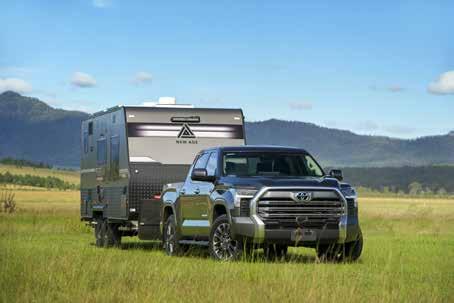
Australia’s leading transport and logistics specialist insurance provider has again launched one of the country’s largest fundraisers for Motor Neurone Disease research.
NTI has proudly raffled seven trucks since 2017 in the name of medical research, raising more than 2.5 million dollars for the official NTI Research Grant, in the hope of helping find a cure for the disease which claims the life of two Australians every day.
For the first time, this year’s prize features two vehicles – the highly soughtafter Toyota Tundra, a hybrid full- sized ute named ‘Dusty’, and behind her – a New Age Manta Ray 19ft expedition caravan.
NTI’s CEO Tony Clark said the last time NTI raffled a new vehicle, instead of a
restored classic, was a 2022 expedition truck which set a fundraising record of $555,850.
“When deciding what vehicle to make the 2025 MND raffle prize, we thought ‘why not mix it up again?’ offering a turnkey for offroad holidays and adventuring. For the first time, the raffle prize will feature two vehicles – a pick-up and a caravan,” Mr Clark said.
“The Toyota Tundra is the most powerful Toyota ever sold in Australia, and while ‘Dusty’ has exceptional off- road capability, the vehicle doesn’t compromise on comfort, including a 14" multimedia display that connects with both Apple and Android devices, wireless phone charging, and dual-zone climate control.
“Dusty’s also incredibly safe, with Toyota’s Safety Sense technology that
that time by over 25 per cent, well above the national rate of just below 16 per cent.
While the State contributes almost half of the value of the nation's exports, global pressures and uncertainty means this success cannot be taken for granted into the future. But while there are risks attached to the current and potential ongoing shifts in the global economy, it also presents opportunities for WA and the State's business sector.
includes a pre-collision safety system that detects both pedestrians and cyclists, active cruise control, and lane departure alert with steering assist.”
Mr Clark said the caravan was the perfect choice for adventurous couples wanting to explore more of Australia’s outback.
“The New Age Manta Ray 19ft Couples Expedition MY25 is designed for off-road durability, its features and design ensure it’s a stylish home on wheels,” he said.
“An ensuite with toilet and internal shower, reverse cycle air conditioning, upgraded leatherette upholstery, and a Queen size bed help to make it a dream holiday van.”
“There’s no limit to the locations you can explore; with a 7inch Bluetooth Display, 3000W Inverter/180Amp Charger, 30Amp DC/DC Charger, and 4 x 200W solar panels to help keep all your appliances powered.
“Thanks to Walkinshaw Automotive Group and Toyota for their support in assisting us in securing these two fantastic, and in demand vehicles.”
NTI is dedicated to helping find treatment options for Motor Neurone Disease after former CEO Wayne Patterson lost his battle with the disease in 2018.
“In Australia, around 2,100 people live with MND, and two are diagnosed every day. It’s time to put an end to this horrible disease.”
The prize made its public debut at the 2025 Brisbane Truck Show, and the winner will be drawn Sunday 13 July at the NTI Townsville 500 Supercars event. Tickets can be purchased at raffletix.com.au/ntimndresearchraffle2025
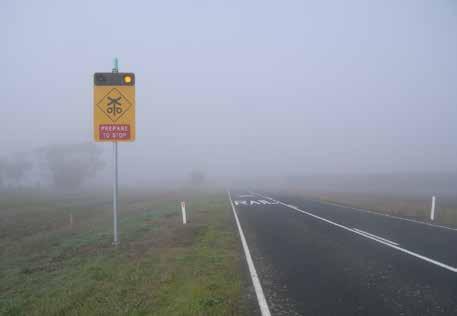

By LARA JENSEN
his month marks a quarter of a century since my youngest brother Christian Jensen (20) and his friends Jess Broad (18), and Hilary Smith (19) were killed when a fully loaded grain train collided with the vehicle they were travelling in on dark at a notorious unlit crossing near Jennacubbine.
This anniversary is particularly difficult, not because of the length of time but rather it signals more than two decades of inaction by the rail industry and our state and federal governments to correct a known and serious safety issue that has contributed to injuries and deaths at regional level railway crossings where our road and rail networks intersect.
That known safety issue is inadequate train and rolling stock illumination. It was flagged as a serious safety issue by WA State Coroner Alastair Hope in 2001 following an inquest into the deaths of Christian, Jess and Hilary and was deemed a contributing factor in the crash that claimed their lives.
Coroner Hope concluded that 'the train involved in the crash was not adequately lit and there was no lighting on it designed to provide an effective warning to motor vehicle drivers at railway crossings' and as such the train 'constituted a very serious hazard indeed.'
He recommended that all locomotives be fitted with external auxiliary lighting to effectively warn motorists of oncoming trains. These recommendations remain unacted by our state and federal government to this day.
Following is part of a letter written by independent road and rail researcher Dr Brett Hughes, published in the West Australian newspaper on May 31st
highlighting the disparity between lighting requirements for trucks and trains.
“I have just driven the Eyre Highway across the Nullarbor. As I watched the oncoming trucks, it was obvious that they were much easier to see in poor light, at dawn and dusk, when their lights were on. In fog, they appeared out of nowhere far too quickly, but they would be shocking without lights. It reminded me about the much poorer lights that trains have and the hazard that dark trains are for road users at level crossings.
“I especially noticed that flashing lights on dozens of trucks helped me to identify oversize vehicles much earlier than trying to gauge the size of a vehicle and whether it was oversized and therefore a hazard. Even in normal daylight.
“It seems obvious that better lights would also help safety on our largest and heaviest land vehicles – trains. Crashes during ‘daylight hours’ include periods
of poor light - dust, rain, fog, dawn, dusk, etc or where trains may be ‘camouflaged’ against backgrounds – where road users need the best possible warning of an oncoming train.
“The purpose of flashing lights in particular is to attract road users’ attention as it does in many other hazardous circumstances familiar to road users. This is different to the purpose of other train or truck lights and why they would benefit railway safety.
“It’s clear that train lighting needs to be improved, and the myth that flashing lights don’t work during daylight hours should be buried once and for all.”
Lighting requirements including flashing amber beacons have been universally mandated for the oversized road transport industry for decades to ensure visibility and road safety.
Furthermore, oversize vehicles and their pilot vehicles must be fitted with a UHF radio to communicate with other road users. Trains that interact with the travelling public at more than 490 unlit regional crossings in WA should no longer be exempt from these decades-old lifesaving safety features.
Trains have no escorts, no roofmounted flashing beacon lights, no side lighting, clearance or signature lighting, no means for train drivers to communicate with motorists and no special permits required to move at night.
Why? Because as rail operators will tell you, “Trains have right of way” and that is supposed to be acceptable. Well, I'm sorry but it’s not.
Why are our governments quick to use the mantra of 'keeping us safe' at every conceivable opportunity still allowing rail operators to operate inadequately lit trains in 2025?
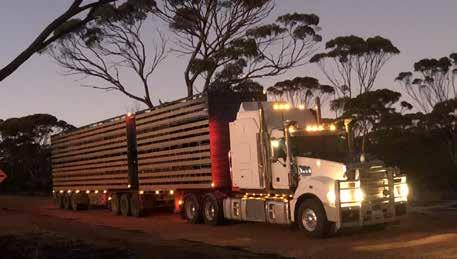
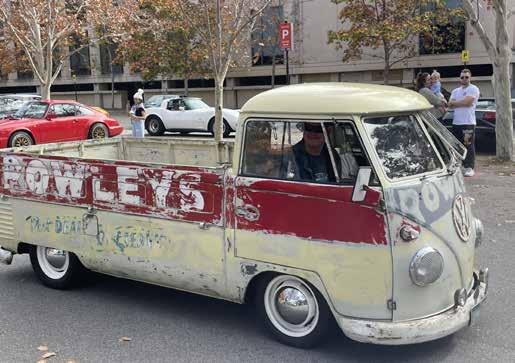
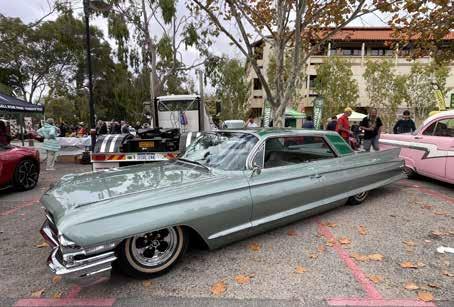

By KEVIN TOOVEY
There have not been many shows on this month. It is hard for organisers to plan big events when the risk of rain is high, and the public may decide to stay home when the weather is not favourable.
I have taken my Dodge truck to a few of the coffee mornings that are held in Perth each month. The organisers have been very accommodating as it is mainly cars, utes, classics and hot rods and parking is a bit harder when you bring a truck, even if it is a small truck.
These events have been very enjoyable, they are on just for a couple of hours and people come because they want to be able
to take their vehicle for a drive. They find like-minded people to talk about cars, restorations, motors and they can look at what others have done to their vehicle. It is all about people with similar interests getting together for a couple of hours.
A bit of cool weather is ok when driving the Dodge as it has no air-conditioning and the coffee mornings have hot coffee and food when you get there. This page is from the Classic Cars and Coffee held at the University of Western Australia. This event attracts hundreds of vehicles every month and is worth a visit.
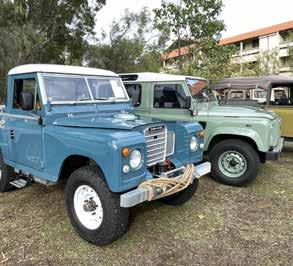
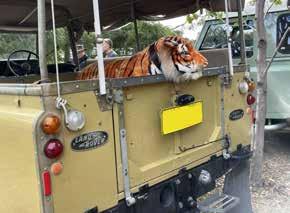
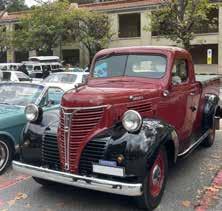
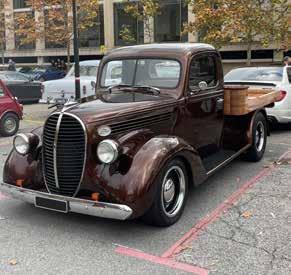
Held at Jaylea’s Patisserie in Willagee, Hopdup Hotrods and Donuts established in 2017 by the Bull family and is a monthly event held on the 3rd Sunday of every month.
It is a hotrod event, for Hotrodders, run by Hotrodders and is a casual morning catch up based on the well know Donut Derelicts, held in Huntington Beach, CA.
To get the young ones involved, they encourage a young kid to be their judge for the morning and pick their favourite car to win a prize. The event is open to all pre-65 Hotrods, Customs and Classics.

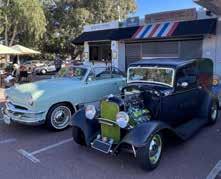
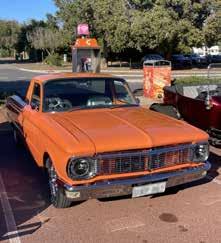
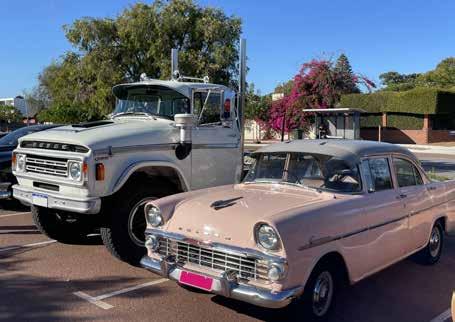
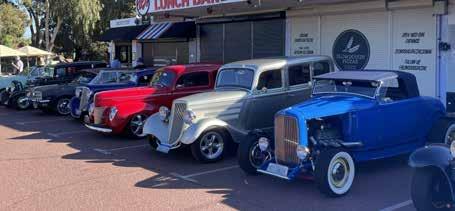
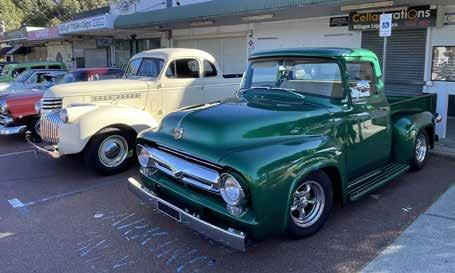
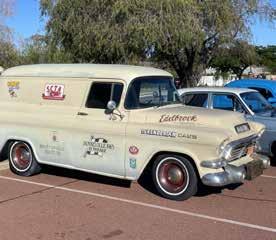
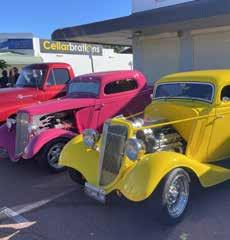

By Russell McKinnon
Construction of a new $8.1m bridge over the Greenough River is to begin later this year. Minister for Transport Troy Buswell announced the “new bridge would improve road safety and minimise road closures caused by small scale flooding events. The Greenough River Bridge was constructed more than 60 years ago and is currently used by more than 2200 vehicles daily, including road trains travelling between Dongara and Greenough,” Mr Buswell said.
Following extensive lobbying by the ATA, the Australian Government has mandated ABS/load proportioning braking for new heavy vehicle trailers. The relevant Australian Design Rule, ADR 38/04, will take effect from July 1, 2014 for all new model trailers and January 1, 2015 for all new trailers. Trailers in service will not be affected.
There were 98 Australian road deaths in January 2014 — one more than in January 2013, according to the latest Road Deaths Australia bulletin. However, the road toll for the 12 months ended January 2014 fell to 1198, compared to 1289 in the year prior. The 40 to 59-year age group has the largest number of deaths, with 324 in the 12 months to January 2014. The 17 to 25 road toll fell by more than 20 percent, dropping from 285 road deaths in the year ended January 2013 to 221 in the year ending January 2014.
From the February 20 One Voice, a startling revelation: “WARTA’s decision not to align with the NHVR project on the Eastern States is being lauded in many areas.
Horrific hold-ups that are laying up trucks for lengthy periods have seen the newly instituted one-stop-shop NHVR seemingly implode.
One Western Australian manager dealing with the Eastern States said, “Their
computers and web site keep crashing; you’re on hold on the phone for up to an hour.
“There are oversize, extra mass vehicles parked up all over the East Coast waiting on permits. At this stage you can’t even get the application in. It is turning into a total disaster,” he said. “I applaud WA for not getting involved in this, and suggest we keep it that way.”
Another WA general manager echoed those comments. “We have also been told 28 days for a permit. I’m not sure how they think anyone can run a heavy haulage transport business or any business that relies on it, under those terms. So our applause to Minister (Troy) Buswell, MRD, Ian (King) and Derek (Nathan) at WARTA and many others for sticking to their guns in relation to the NHVR. It is also not surprising therefore to see so many fleas from the east now trying to move in here to the West. Keep up the good work we are fully behind you in this,” he said.
Main Roads WA’s Director Heavy Vehicle Operations, Pascal Felix, reiterated the need for WA heavy vehicle businesses that operate beyond the WA border need to familiarise themselves with the NHVR and the new Heavy Vehicle National Law rules and regulations. “We are aware that the NHVR is experiencing some systems problems that are impacting on permit turnaround times. If you are using the NHVR journey planner, bear in mind the NHVR has no jurisdiction in WA. The routes shown are for planning purposes only. You are reminded that there is no change for customers requiring access to WA roads,” he said.
“Heavy vehicle access will continue to be determined by Main Roads WA in consultation with local governments. WA Heavy Vehicle Accreditation (WAHVA) remains compulsory for operators seeking
WARTA’s decision not to align with the NHVR project on the Eastern States is being lauded in many areas with some saying I applaud WA for not getting involved in this, and suggest we keep it that way
access for Restricted Access Vehicles in WA.
Main Roads WA rolled out the second stage of the NHVR project on February 10. This includes permit services and coordination of compliance and enforcement activities.
Also, “State Governments have intervened to help the National Heavy Vehicle Regulator (NHVR) process permit applications as the new agency continues to struggle with its workload. The Queensland Government has taken the drastic step of taking back control of processing applications for oversize, over-mass and special purpose vehicles after the trucking industry complained about the service it was receiving from the NHVR. Victoria has dispatched two of its permit officers to the NHVR’s head office in Brisbane to try and clear the backlog of permits that have continued to build up since the regulator took over responsibility for permit applications on February 10.”

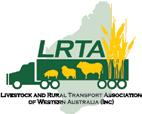

The Livestock and Rural Transport Association of Western Australia (Inc) is the only transport association in WA specifically representing rural transporters.
We are a strong voice for rural WA, ensuring that policy decisions support the viability and safety of rural transporters, primary industry and the communities they service.
Members of the Management Committee are hands on business people, most of whom would drive a truck weekly and travel on nearly every road in WA’s 150,000 km road network in the course of a year.
This close proximity between transporting operations and the advisory role means that representatives of the Association are at the coal face and as such are able to provide that all too rare practical hands on advice in committees, consultative forums and meetings.

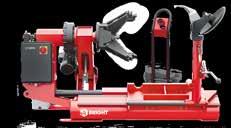
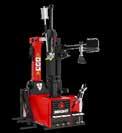
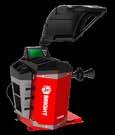
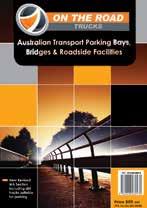

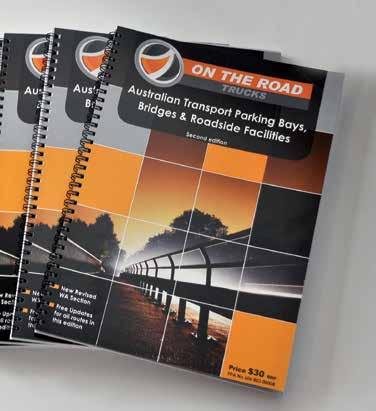



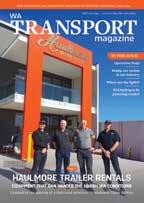
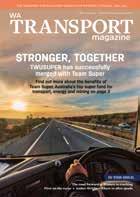
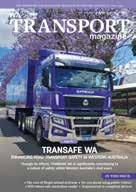
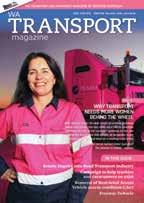
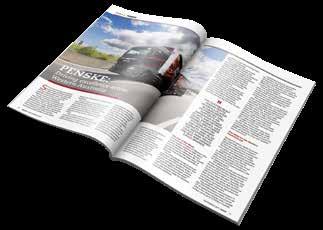
Our digital editions (11 per year) are available at ‘no cost’ and to subscribe please email karen@angrychicken.com.au
You will receive a monthly email from us and be given a link to a high quality Flip Book that you can download and access any links within the publication.
We do not make any profit on our subscriptions. Due to the rising costs of postage and producing the magazine we charge only ‘what it costs us’ to print and post your publication to you.
To receive the hard copies, please email karen@angrychicken.com.au with the following details and you will receive an invoice with EFT details:
Visit www.isubscribe.com.au/wa-transport-magazine-subscription.cfm
Note, this option costs $140 (one year) and the price includes ISUBSCRIBE fees on top of $130 base cost (printing and postage only). Thank you for your understanding and support of an independent publisher who has been producing the WA Transport Magazine for 30 years
